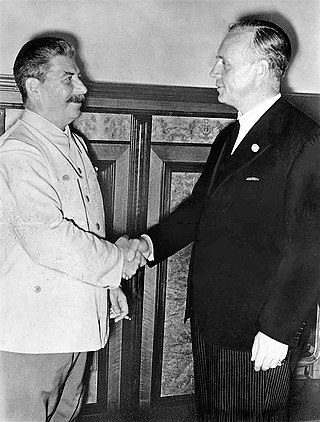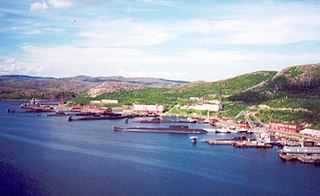
The Molotov–Ribbentrop Pact, officially the Treaty of Non-Aggression between Germany and the Union of Soviet Socialist Republics, was a non-aggression pact between Nazi Germany and the Soviet Union with a secret protocol that partitioned Central and Eastern Europe between them. The pact was signed in Moscow on 23 August 1939 by German Foreign Minister Joachim von Ribbentrop and Soviet Foreign Minister Vyacheslav Molotov. Unofficially, it has also been referred to as the Hitler–Stalin Pact, Nazi–Soviet Pact, or Nazi–Soviet Alliance.
The Battles of Narvik were fought from 9 April to 8 June 1940, as a naval battle in the Ofotfjord and as a land battle in the mountains surrounding the north Norwegian town of Narvik, as part of the Norwegian Campaign of the Second World War.

Operation Silver Fox from 29 June to 17 November 1941, was a joint German–Finnish military operation during the Continuation War on the Eastern Front of World War II against the Soviet Union. The objective of the offensive was to cut off and capture the key Soviet Port of Murmansk through attacks from Finnish and Norwegian territory.

German–Soviet Union relations date to the aftermath of the First World War. The Treaty of Brest-Litovsk, dictated by Germany ended hostilities between Russia and Germany; it was signed on March 3, 1918. A few months later, the German ambassador to Moscow, Wilhelm von Mirbach, was shot dead by Russian Left Socialist-Revolutionaries in an attempt to incite a new war between Russia and Germany. The entire Soviet embassy under Adolph Joffe was deported from Germany on November 6, 1918, for their active support of the German Revolution. Karl Radek also illegally supported communist subversive activities in Weimar Germany in 1919.
The German–Soviet Credit Agreement was an economic arrangement between Nazi Germany and the Soviet Union whereby the latter received an acceptance credit of 200 million ℛ︁ℳ︁ over 7 years with an effective interest rate of 4.5 percent. The credit line was to be used during the next two years for purchase of capital goods in Germany and was to be paid off by means of Soviet material shipment from 1946 onwards. The economic agreement was the first step toward improvement in relations between the Soviet Union and Germany.

Zapadnaya Litsa is a naval base of the Russian Navy, part of the Russian Northern Fleet, located in Murmansk Oblast, Russia.
Operation Platinum Fox was a German and Finnish military offensive launched during World War II. Platinum Fox took place on the Eastern Front and had the objective of capturing the Barents Sea port of Murmansk. It was part of a larger operation, called Operation Silver Fox.

German submarine U-36 was a Type VIIA U-boat of Nazi Germany's Kriegsmarine which served during World War II. She was constructed in the earliest days of the U-boat arm at Kiel in 1936, and served in the pre-war Navy in the Baltic Sea and North Sea under Kapitänleutnant (Kptlt.) Klaus Ewerth. Korvettenkapitän (K.Kapt.) Wilhelm Fröhlich took command in October 1938 and continued in the role until the boat was lost.

German submarine U-38 was a Type IXA U-boat of Nazi Germany's Kriegsmarine that operated during World War II.

HNoMS Nordkapp was the lead ship of the Nordkapp class of fishery protection vessels. She was launched 18 August 1937 at Horten naval shipyard, with yard number 123. She had one sister ship, HNoMS Senja. Nordkapp was named after the North Cape in Finnmark. As was typical of her class, Nordkapp was very unstable in rough seas and was viewed from the beginning as a second-rate vessel. Nordkapp sailed throughout the Second World War and saw service in several theatres.

The Zapadnaya Litsa is a river in the north of the Kola Peninsula in Murmansk Oblast, Russia. It is 101 kilometres (63 mi) long, and has a drainage basin of 1,690 square kilometres (650 sq mi). The Zapadnaya Litsa River originates on the Kuchintundra and flows into the Barents Sea. Its biggest tributary is the Lebyazhka River.
The 1940 German–Soviet Commercial Agreement was an economic arrangement between the Soviet Union and Nazi Germany signed on 11 February 1940. In it the Soviet Union agreed in the period from 11 February 1940 to 1941, in addition to the deliveries under German–Soviet Commercial Agreement, signed on 19 August 1939 to deliver commodities to the value of 420 to 430 million Reichsmarks.
The German–Soviet Border and Commercial Agreement, signed on January 10, 1941, was a broad agreement which settled border disputes, and continued raw materials and war machine trade between the Soviet Union and Nazi Germany. The agreement continued the countries' relationship that started in 1939 with the Molotov–Ribbentrop Pact, which contained secret protocols that divided Eastern Europe between the Soviet Union and Germany. The relationship had continued with the subsequent invasions by Germany and the Soviet Union of that territory. The agreement contained additional secret protocols, settling a dispute regarding land in Lithuania, which had been split between both countries. The agreement continued the German–Soviet economic relations that had been expanded by the 1939 German–Soviet Commercial Agreement and the more comprehensive 1940 German–Soviet Commercial Agreement.

After the Nazis rose to power in Germany in 1933, relations between Nazi Germany and the Soviet Union began to deteriorate rapidly. Trade between the two sides decreased. Following several years of high tension and rivalry, the two governments began to improve relations in 1939. In August of that year, the countries expanded their economic relationship by entering into a Trade and Credit agreement whereby the Soviet Union sent critical raw materials to Germany in exchange for weapons, military technology and civilian machinery. That deal accompanied the Molotov–Ribbentrop Pact, which contained secret protocols dividing central Europe between them, after which both Nazi forces and Soviet forces invaded territories listed within their "spheres of influence".

German–Soviet Axis talks occurred in October and November 1940 concerning the Soviet Union's potential adherent as a fourth Axis power during World War II. The negotiations, which occurred during the era of the Molotov–Ribbentrop Pact, included a two-day conference in Berlin between Soviet Foreign Minister Vyacheslav Molotov and Adolf Hitler and German Foreign Minister Joachim von Ribbentrop. The talks were followed by both countries trading written proposed agreements.
The 14th Rifle Division was an infantry division of the Red Army. Formed in Moscow in 1922, the division spent most of the interwar period at Vladimir. After moving to the Kola Peninsula during the Winter War, the division fought on that front during the Continuation War. After the end of the Continuation War it became the 101st Guards Rifle Division.

Lützow was a heavy cruiser of Nazi Germany's Kriegsmarine, the fifth and final member of the Admiral Hipper class, but was never completed. The ship was laid down in August 1937 and launched in July 1939, after which the Soviet Union requested to purchase the ship. The Kriegsmarine agreed to the sale in February 1940, and the transfer was completed on 15 April. The vessel was still incomplete when sold to the Soviet Union, with only half of her main battery of eight 20.3 cm (8 in) guns installed and much of the superstructure missing.

Empire Endurance was a 8,514 GRT steam cargo liner that was built in 1928 as Alster by Deschimag Werk Vulkan, Hamburg, Germany for the shipping company Norddeutscher Lloyd. In the years leading up to the Second World War Alster carried cargo and passengers between Germany and Australia. After the outbreak of war she was requisitioned by the Kriegsmarine for use as a supply ship.

Arctic naval operations of World War II were the World War II naval operations that took place in the Arctic Ocean, and can be considered part of the Battle of the Atlantic and/or of the European Theatre of World War II.

Gromky was one of 29 Gnevny-class destroyers built for the Soviet Navy during the late 1930s. Completed in 1938, the ship was initially assigned to the Baltic Fleet before being transferred to the Northern Fleet in mid-1939 where she played a minor role in the 1939–1940 Winter War against Finland.














